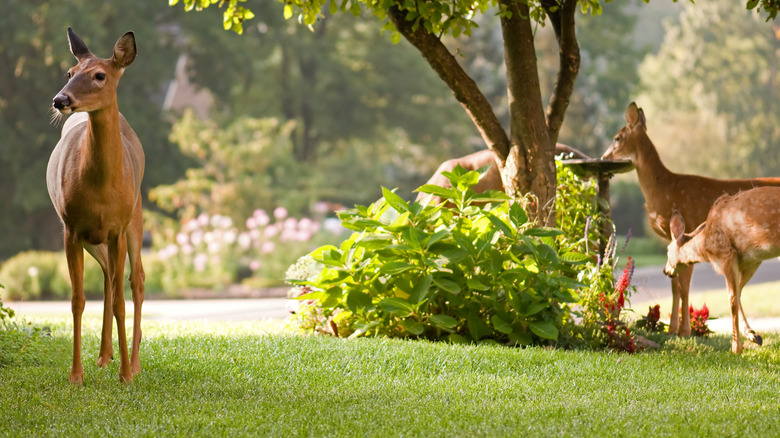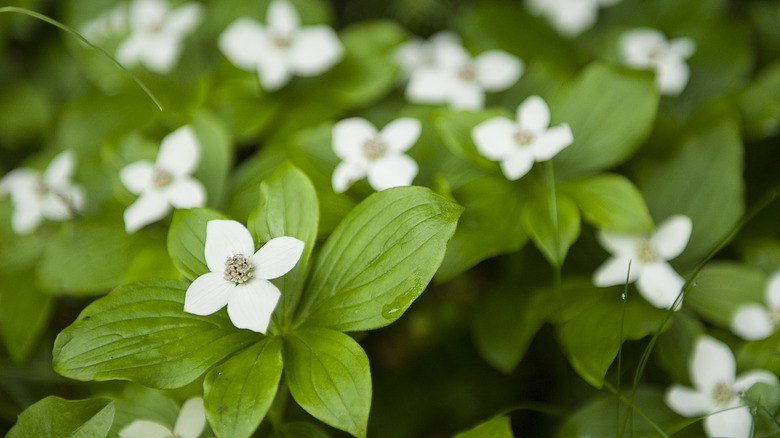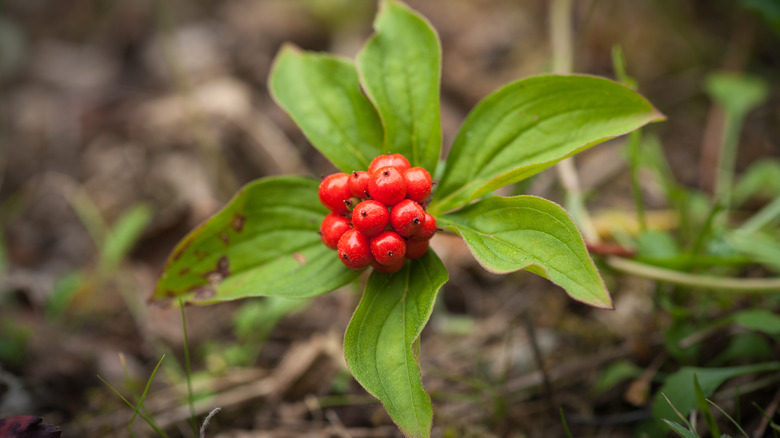The Deer-Resistant Ground Cover That's Perfect For A Shade Garden
Trying to find visually interesting flowering ground cover for shading spots can be a challenge. Trying to find one that is also deer and rabbit resistant can seem almost impossible. Luckily, the perfect deer-resistant, shade-tolerant ground cover does exist, and it's even native to North America. The beautiful bunchberry (Cornus canadensis) thrives in cool and shady conditions and is seldom bothered by rabbits or deer.
Bunchberries are part of the dogwood genus (Cornus spp.), but unlike dogwood trees that can easily grow to 25 feet, bunchberries seldom grow over a foot tall and wide. Native to Canada and the northern U.S., bunchberries are perennial in Zones 2 through 6. Unfortunately, they struggle with high heat, so they rarely thrive in southern climates. Growers in warmer zones may want to try bugleweed (Ajuga reptans) as a deer-resistant ground cover instead, as it is hardy to Zone 9. Bunchberries also aren't the right groundcover for areas prone to drought. Sedum may instead be the perfect ground cover for those conditions.
Caring for bunchberries
Bunchberries grow best in moist soil and appreciate growing media with plenty of organic matter. They also need acidic soil with a pH under 6 to grow their best. As they struggle with too much sun, bunchberries should be planted in at least partial shade. Bunchberries spread primarily by rhizomes and in the right conditions will slowly fill in, providing you with a beautiful ground cover colony.
Bunchberry plants are regularly available to purchase in garden centers in the northern U.S., and they can also be easily propagated from cuttings or grown from seed. Bunchberry seeds require moist cold stratification to germinate well, though. This can be most easily achieved by directly sowing the seeds in the fall and allowing them to go through the winter outdoors. Alternatively, seeds can be refrigerated in a plastic bag with a moist paper towel or other substrate for several weeks.
Using bunchberries in the garden
Because bunchberries require moist soil and plenty of shade, they should be kept far away from rose gardens and other areas with similarly sunny and relatively dry conditions. They grow well in the dappled sunlight often found under mature trees or when paired with plants like red twig dogwood (Cornus sericea) and bleeding hearts (Dicentra spectabilis) which enjoy similar conditions. Ferns and astilbe also make excellent companions for bunchberries. Bunchberries' distinctive light-green leaves look especially lovely against a backdrop of darker foliage like that of the dark side of the moon astilbe.
While deer and rabbits leave bunchberries alone, pollinators love bunchberries' beautiful white flowers, which explode open every spring. Bunchberries continue to provide interest throughout the season, as edible red berries replace their white flowers as summer goes on. These berries provide a fantastic food source for songbirds and can also be made into preserves.


